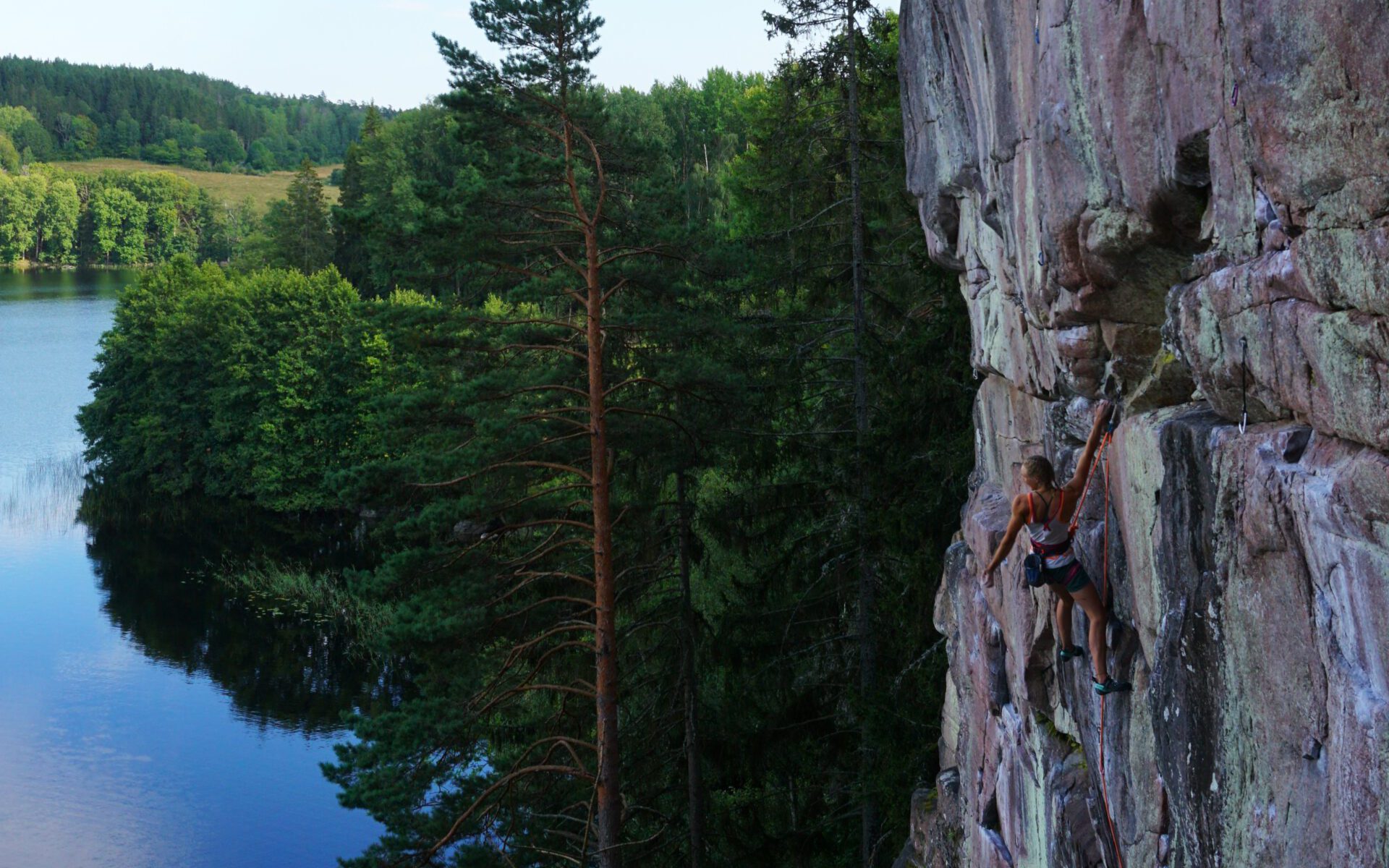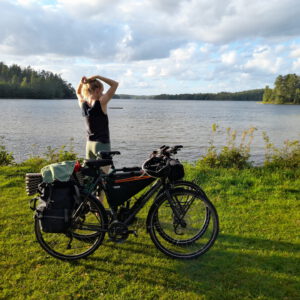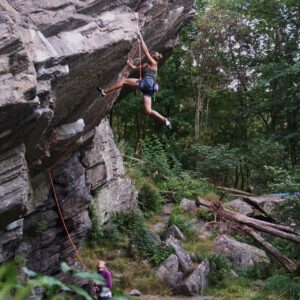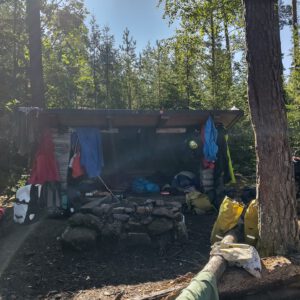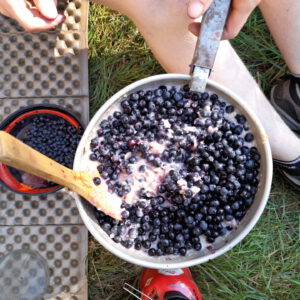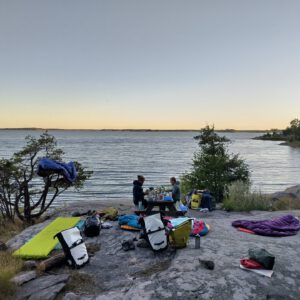In the past we have tried to get to famous sport climbing crags using a new (to us) mode – ecopointing. This often led to frustration when the local infrastructure was much more car- than bike-friendly. So this time we thought of a destination, a route, where ecopointing would be more fun than car travel. Where ecopointing is not about overcoming obstacles, but about enjoying the beauty of change. So we cycled from Gothenborg to Stockholm, climbing on six crags along the way, such as Sjöända. Stunning, ca. 25m high main wall with slightly overhanging, crimpy, and technical climbing. Mostly 7b and harder, but some nice, easier routes can also be found. The side walls offer a bit shorter, vertical, partly slabby climbing in easier grades. It is located directly next to a beautiful lake where you can refresh yourself on a warm summer day. Perfect summer crag as the shades moves in during early afternoon.
What we loved about Sweden: “Allemansrätten”, “Fika” (coffee break) and the granite! Swimming in lakes twice a day (and not missing a shower in three weeks), cycling through marvellous nature, eating freshly picked berries in our porridge and sleeping in shelters, “badsplats” and the like, sometimes even with (dry) toilets – for free and in places you would not get to by car!
How to get there
From Nuremberg to Gothenborg by Flixbus
Duration: 21 hrs. Tips: Make a reservation for your bike and travel with less stress. Put all your small bike bags in a few large plastic bags (e.g. from IKEA) to avoid paying for extra luggage. For the first night, we stayed in a bikers’ hostel in Gothenborg which was perfect to have a well-rested start into the trip and to get the bikes ready.
From Gothenborg, we cycled to Sjöända (370 km) and climbed along the way. We then continued to Stockholm. For more crags that we visited, please see below (Tips).
From Stockholm to Nuremberg by nightjet and ICE
Duration: 23 hrs. We took the cheap night train from Stockholm to Berlin. It was comfortable but we had to dismantle our bikes and squeeze them in between the luggage. From Berlin to Nuremberg we took the ICE, which was the most comfortable public transport as we had reservations for our bikes and could basically get on with all our stuff.
Where to stay
It is possible to put up 2-3 small tents directly next to the crag Sjöända, ca. 10 min walking distance from the gravel road where it is best to leave the bikes. However, you should not stay there for too many nights as some locals are rather adversarial towards climbers who stay longer. Bring enough mosquito-protection to survive the evening.
Allemansrätten: “The Right of Public Access is a principle, protected by the law, that gives all people in Sweden the freedom to roam free in nature. Sleep on mountaintops, by the lakes, in quiet forests or beautiful meadows. Take the kayak out for a spin or experience the wildlife firsthand. Pick berries, mushrooms and flowers from the ground – all completely free of charge. The only thing you have to pay, is respect for nature and the animals living there.” We really enjoyed Allemannsrätten and had some great campsites. To find them, study the maps and look for jetties, "badsplats" or shelters (see below).
Shelters: This mobile app/website allows you to get out into nature and easily find a shelter when you want to camp in the wilderness. Often there are comments about the condition of the shelter. The shelters are often in beautiful places, close to a lake or the sea and sometimes with dry toilets. We have met people who hike in Sweden without a tent and only sleep in these shelters. Also you often find nice camps when searching for “badsplats” on google maps. Just make sure you follow a few common sense rules.
Leave no trace: When camping in the wilderness, one rule is even more important than when you are just out for the day - leave no trace of your pee and poop. We always take a small, lightweight aluminium shovel with us to easily dig a cat hole. Keep it in a bag with disinfectant gel, toilet paper and a bag for used toilet paper and you have a handy shitkit. Do not use soap, detergent or shampoo outdoors, even supposedly biodegradable products have a negative impact on water bodies.
Ask locals for water refill: As our water was usually used up after one day but the next public access to drinking water is often far from the crags, we asked locals for a refill of our bottles and water bags, and mostly faced positive response and nice conversations. As the next lake is usually not far, you can also bring a filter, but we preferred tab water whenever possible.
How to reach the crag(s)
In Sjöända, we stayed directly next to the crag. For the other crags, sometimes we camped right next to the crags. Other times we stayed in a shelter and had to walk or cycle (max 35 min) to get there.
Tips
Plan ahead for supermarkets and gas: Not every small village has a supermarket, only the bigger towns sell gas. So make sure you take enough with you. We often had supplies for the three days we stayed at a crag (e.g. Sjöända and Tosseryd), which was great because it saved time and energy we could spend climbing instead of cycling to get food.
Plan carefully with Komoot: Komoot does not always work perfectly in Sweden. If you use the "gravelbike" mode, you may end up on hiking trails with your bike (and all those heavy bags) on your shoulder. When using the "Bike" or "Racing bike" modes, Komoot sometimes navigates you on highways. So plan your trip in advance, check the roads and edit your route before you start to avoid surprises.
Topos: Find updated topos on 27 crags. To see the topos and not just the list of routes, you need to buy a membership (for a monthly or yearly). Highly recommended, especially when moving around by bike as we did. Otherwise we would have needed to bring at least four different guide books with us (which might not even be as much up to date as 27crags which is very popular among Swedish climbers).
Other crags we visited along the way:
- From Gothenborg to Korpaberget by bike (Distance: ca. 60 km). Crag: Nice, mostly steep and crimpy climbing. Tips: There is a shelter on a nearby lake where you can enjoy complete privacy in the middle of a beautiful forest. However, it is a bit of a struggle to get up there with heavy bikes and unless you have a mountain bike, you will have to push or leave the bike for the last part. It is also very nice to bivouac on the rocks directly in front of the crag.
- From Korpaberget to Tosseryd by bike (Distance: ca. 50 km). Crag: Mostly vertical climbing on slopy crimps. Not the place to chase high grades (most routes felt really tough for the grade), but definitely high-quality rock with good moves. Nice and quiet place with a beautifully located shelter within 10 min walking distance. To get to the shelter you need to leave your bike for the last hundred metres and carry the bike bags up a rather steep slope. But it is definitely worth the effort!
- From Tosseryd to Sjöända by bike (Distance: ca. 260 km, we did it in three days)
- From Sjöända to Solvik by bike (Distance: ca. 50 km). Crag: Beautiful red granite, which offers slightly overhanging, crimpy climbing in the grades 6c and harder. High-quality routes, even though one should not get too frustrated about some chipped holds. There is another crag closeby which offers also easier routes (but we were not there, so no (dis)recommendation possible). Tips: Stay at Borkhult Laphem or camp at the lake Borken. Borkhult Lapphem: If you want to treat yourself, we can warmly recommend Borkhult Lapphem close to the climbing crag Solvik! We enjoyed a sauna, a breakfast buffet and dinner here on a rainy day - everything was fantastic and a lot of emphasis is placed on sustainability! There was also live music one evening. Unfortunately, they didn't have any rooms available, otherwise we would have loved to stay here. There's also a wonderful place nearby on Lake Borken where you can camp wild for a night.
- From Solvik to Örnberget by bike (Distance: ca. 253 km, three days). Tips: On the way you will pass the Stendörren Nature Reserve, a protected archipelago with some camping & hiking areas that are only accessible by boat or canoe. However, there are also stunning coastal shelters and campsites that can be reached by bike (see shelter map). Crag: Being only 20km south of Stockholm’s city centre, Örnberget is the “Utegym” (outdoor gym) of the Stockholm climbing community, and it rarely happens that you end up being there alone. Easier, slabby routes can be found on the south facing wall, but the main attraction is for sure the 20m high west facing part, which offers some of Stockholm’s classics from 7a upwards in slightly to very steep terrain. Right next to a wonderful lake. Tips: Even though it is already on the outskirts of Stockholm, it is amazing to camp on top of the crag! There are some good places to put up the tent and the view is definitely worth hiking up.
- From Örnberget to Stockholm by bike (Distance: ca. 25 km). Good biking ways lead you all the way to Stockholm, and also the city itself is very bike friendly. The first third is quite hilly, but very beautiful in forests and next to lakes. After that you clearly feel that you are approaching a big city, first biking through an industrial area and then getting closer and closer to town.
- From Stockholm to Skevik by (ferry and) bike (Distance: 25 km). Skevik is located in Stockholm’s archipelago and can be reached either by bus, by bike or by ferry+bike. We chose ferry+bike to get there (stop: Koviksudde, then bike for 10 min); back to town we biked the whole way, which is ca. 25km on nice bike ways, mostly flat. Crag: Skevik is also home to some Stockholm classics, especially in the upper grades (from 6c). But there are also easier routes and the place itself has a magic that definitely makes a visit worthwhile. The vertical wall is up to 25 metres high and offers technical climbing on perfect crimps. However, in summer the crag is more for early birds - from mid-afternoon, almost all the routes are exposed to the sun and some of the climbs might feel much harder.
How to book the trip
Flixbus (including ferry), Night train (including ferry), ICE train
About the author
Sophie and Nadja, travelling with Sofie, Jony and Hannah from Ecopoint Frankenjura

